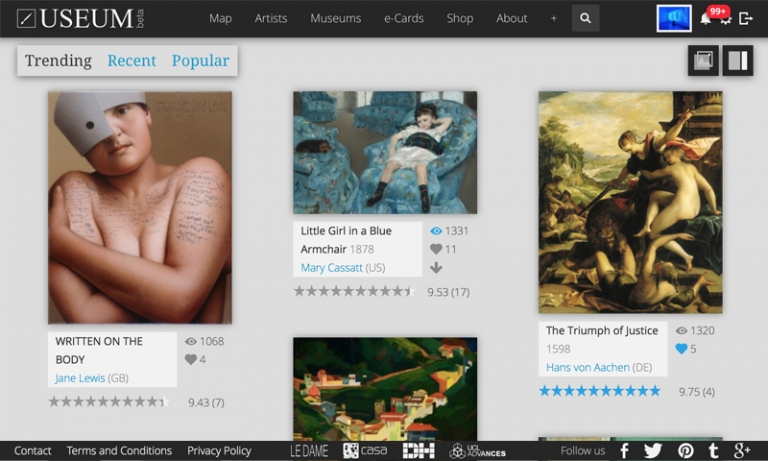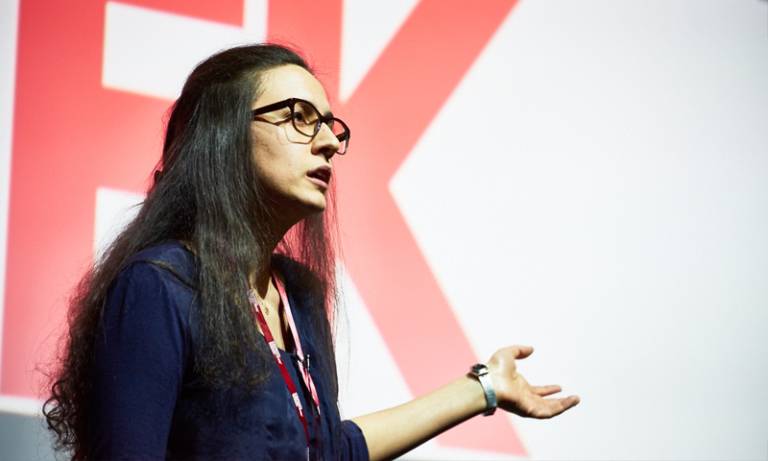Democratising Art through the ‘Museum Without Walls’
6 December 2017
Dr Foteini Valeonti reports on USEUM, her crowd-sourced art platform that offers unprecedented access to art online.

An imaginary museum that exhibits all of the world’s greatest art under one roof, free of geographical constraints, was first envisioned by French philosopher Andre Malraux in his book Le Musée Imaginaire (1965). A realisation of Malraux’s ‘museum without walls’ (as it was translated) is USEUM.org, an online art museum that exhibits 84,000 paintings by 2,000 participant painters and hundreds of museums from 107 countries around the world. True to Malraux’s vision, USEUM is the first platform that exhibits a collection of paintings, drawings and illustrations that span from the fourteenth century up to the present day, ranging from Old Masters to contemporary art.
USEUM started as the inter-disciplinary PhD project of Foteini Valeonti based between the Bartlett Centre of Advanced Spatial Analysis and the UCL Centre for Digital Humanities, with goal to increase access to art online, by taking advantage of crowdsourcing. A few years later, USEUM exhibits thousands contemporary paintings by 2,000 artists, as well as famous paintings from 700 museums around the world. Visitors can search, browse and send all artworks as e-cards to their friends; art lovers can even add artworks to the platform, through USEUM’s crowdsourcing mechanisms. USEUM, apart from its exhibition of paintings, also features 22,000 words of Educational Content, which explains key movements from the History of Art in simple language.
Amongst USEUM’s most notable achievements in its efforts to democratise art is that the platform has received more than 140,000 artwork ratings from its members. As a result USEUM proudly exhibits one of the first ever democratically-curated art exhibitions. The rankings of the works presented on platform’s landing page, on its search results, as well as the artwork recommendations, are all implicitly crowdsourced from USEUM’s members, without the interference of any expert curator.
USEUM’s most impressive feature however, could be considered the Download Artworks feature. More than a quarter of its collection – some 21,000 artworks – can be downloaded and used for any purpose, even commercially, anywhere around the world. The ‘Download Artworks’ feature, which could be considered the epitome of art accesssibility on-line, is based on Dr Valeonti’s extensive work on the Open Content movement, examining art copyright law and the individual copyright policies of the participant museums. To understand the amount of preparative work that was required for the Download Artworks feature, nearly five thousands of the artworks that are free for download on USEUM, were copyright-vetted individually by Dr Valeonti herself.

USEUM, as a PhD project, presents a systematic approach to ease access to art online, by taking advantage of newly emerged phenomena, such as crowdsourcing and gamification. The Open Content movement, and the seismic shift it brought to art copyright online, also played a critical part in this project. USEUM’s significant amount of work contributes to relevant literature for future scholars and practitioners in the field of art accessibility on the Internet. Finally, the platform of USEUM, receives nearly a thousand visitors every day, offering value to people beyond academia, providing countless features to casual Internet users all around the world.
Dr Foteini Valeonti completed her doctorate ‘USEUM: Making Art Accessible with Crowdsourcing and Gamification’ in November 2017.
Reference:
Malraux, A., 1965. Le musée imaginaire, Paris: Gallimard.
 Close
Close

